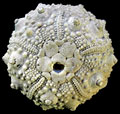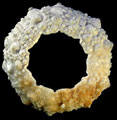The Echinoid Directory
Pseudosalenia Cotteau, 1859, p. 215
[=Prandinia Vadet, 2000, p. 93, type species Cidarites interpunctata Quenstedt, 1852, p. 576; =Amphisalenia Pomel, 1883, p. 95 (nomen nudum). ]
| Diagnostic Features |
|
|---|---|
| Distribution | Late Jurassic (Late Oxfordian to Tithonian) to ?Cenomanian of Europe, possibly also Middle East and Central America. |
| Name gender | feminine |
| Type | Pseudosalenia flexuosa Cotteau, 1859, by monotypy [=Acrosalenia aspera L. Agassiz, 1838] |
| Species Included |
|
| Classification and/or Status |
|
| Remarks | Distinguished from Heterosalenia by its periproct lying symmetrically along the amb III - interamb 5 axis rather than offset to ocular plate I. Distinguished from Hyposaleniinae by having perforate interambulacral tubercles. The narrow unigeminate ambulacra distinguish it from Acrosalenia. Whether any of the Cretaceous forms truly belong to this genus is uncertain; modern redescriptions of these taxa are needed. |




